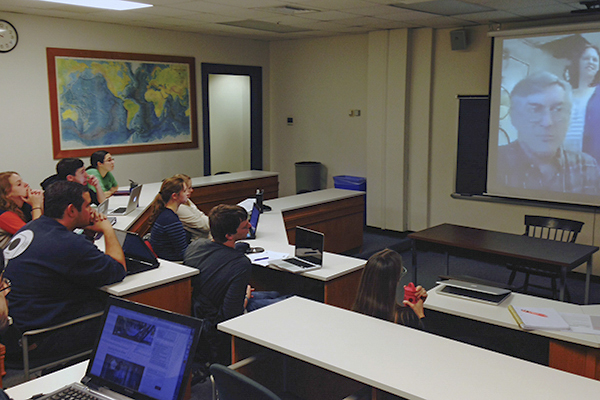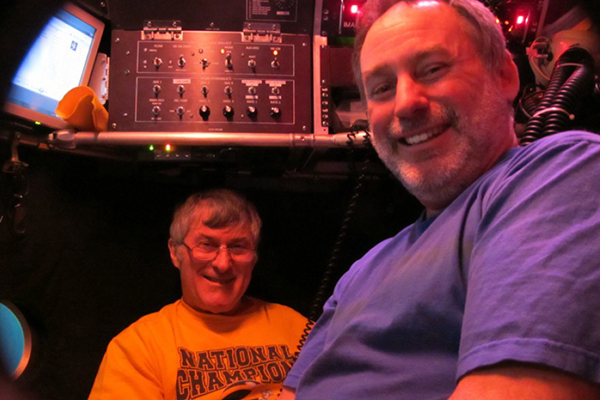


Skype by sea
CEOE researchers update students from ship that is testing new Alvin submersible
10:27 a.m., March 27, 2014--The deep-sea vehicle Alvin has been out of commission for three years as it underwent a major overhaul. The famous research submersible is now back in the water, and students in the University of Delaware’s College of Earth, Ocean, and Environment (CEOE) were among the first to get to ask about the success of recent test dives.
CEOE faculty members George Luther and Jonathan Cohen dialed in via Skype from the research vessel Atlantis, the Alvin’s mother ship, to Robinson Hall to share updates with marine science majors. The class was made up of juniors eager to gain field experience of their own.
Campus Stories
From graduates, faculty
Doctoral hooding
“I think I speak for pretty much everyone here,” said student Chris Grasso. “What do we have to do to get on the Alvin?”
The researchers aboard the ship, with the submersible situated right behind them, laughed before advising the class to seek out scientists who work in the deep ocean and regularly conduct dives. Looking for any opportunities to help on scientific cruises, like those carried out by CEOE researchers on UD’s R/V Hugh R. Sharp, also helps.
But while getting “in the ball” — as the interior of the Alvin’s newly rebuilt titanium passenger sphere is called — sounds exciting, Luther shared firsthand experience about the realities of plunging into the depths for daylong missions in tight quarters.
“You couldn’t even stand up in the Alvin before,” he said.
Colleagues plagued with leg cramps nearly had to kick each other in the head to stretch out, but now they have a little more room and each have portholes to look out from. The temperature gets cooler as the sub descends, with researchers adding clothing layers and thick socks, and deep-sea dining is simple fare: peanut butter and jelly or deli meat sandwiches, along with a piece of fruit and a chocolate bar.
“I don’t think I want to tell you how we have to go to the bathroom,” Luther said.
On a more serious note, working inside the sphere comes with serious safety precautions, which researchers are trained in before going underwater. The submersible travels to depths where pressure is crushing and battery limits curb dive times.
Luther shared that during one test on the science verification cruise, which took place off Louisiana March 13-26, a carbon dioxide scrubber malfunctioned and occupants used Emergency Breathing Apparatuses as the sub transported them to safety over the course of one hour.
Luther and Cohen explained that such occurrences are exactly why the test cruise, done in relatively shallow water, is a necessary step. The focus of the cruise was on making sure all the technology and equipment function properly.
Other systems worked smoothly, with high-definition video cameras capturing vivid imagery and manipulator arms nimble enough to grasp a clam without squashing it.
Students asked how deep the Alvin would eventually be able to go (4,500 meters) and how climate change is impacting deep-sea biodiversity (there’s not a lot known at the moment, but an upcoming cruise on coral research could shed light).
During the 45-minute conversation with Joanna York’s class, the Skype connection was about what one would expect from a ship, with the image blurry and a slight lag time in the audio feed — but the students’ interest was piqued and they still wanted to know more.
“It would be cool if he came back to our class,” said student Taylor Daley.
Article by Teresa Messmore
Alvin photo by Amanda Demopoulos, U.S. Geological Survey; courtesy of Peter Girguis, chief scientist, Harvard; funding agencies: NSF, ONR, NOAA; copyright Woods Hole Oceanographic Institution









